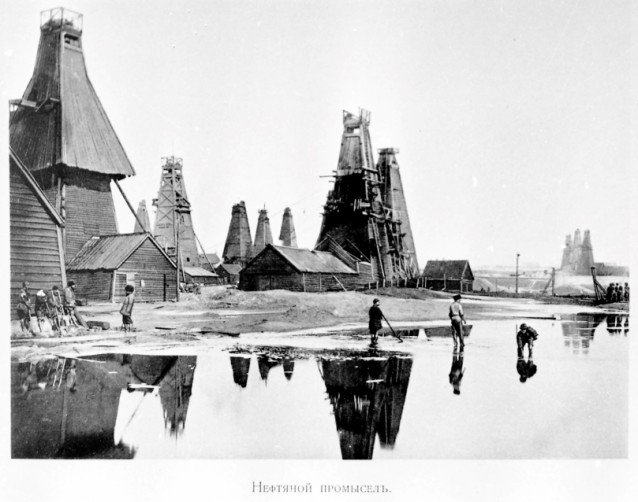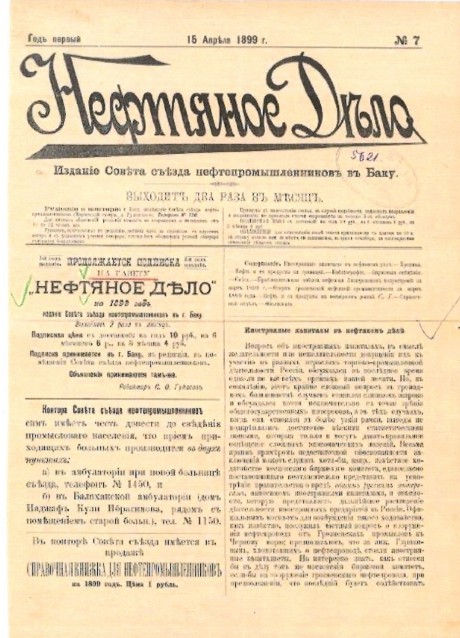Next year (2019) will mark 120 years since the maiden publication of Russia’s first scientific oil journal which was published in Baku. Azerbaijani oil industry expert Mir-Yusif Mir-Babayev tells its incredible story...
The year 1898 saw Russia rise to first among the world’s biggest oil producers, with 95 per cent of the empire’s oil production taking place in Azerbaijan. That same year saw Russia export 23 million poods of Baku kerosene to Europe (one pood equals 16.4 kilograms. In today’s measurement, one barrel of oil would be approximately 8.4 poods – Ed.). In 1899, the year Oil Business was first published, Baku oilfields produced 525.2 million poods, which increased to 603.8 million in 1900 and 671.6 million in 1901. This meant that Baku was producing more than half of the world’s oil at the time, far outpacing countries such as the United States, Argentina and Peru.
The beginning of the 20th century saw an influx of foreign capital, especially English, into Baku. From 1898 to 1903, British industrialists invested more than 47 million roubles into enterprises in the Baku region. By 1902, there were 11 separate English ventures holding capital of 39.4 million rubles. Due to this monopolization of the oil industry, the publication of an objective oil periodical became both necessary and timely.
Reflecting the needs of the oil industry
Oil Business began life as a bi-weekly journal and was first published on 10 January 1899 by the Congress of Baku Oilmen. Functioning from 1884 right up to the revolutions of 1917, this organisation’s purpose was to help organize and coordinate the activities of Russian entrepreneurs and give them the opportunity to express their needs and desires to the government. Oil Business functioned as its media arm and served to inform the public and scientific community about the key issues affecting the Russian oil industry and discuss the most rational ways of solving them.
In its first issue Oil Business published an appeal “From the Editorial Office,” which emphasized that the publication would reflect the issues and needs of the oil industry in its totality, as well as issues related to it, publish information on oil production, consumption, distribution of oil and its products, as well as the work of oil refineries. The main focus would be on technical and economic aspects of oil production and processing, its transportation, storage and marketing, communication between the oil industry and the steam fleet, analysis of the Russian (Baku) and foreign oil markets.
Oil Business considered itself to be a serious reference publication, collecting scientific articles by leading experts and mining engineers from the Russian Empire. It included articles on a variety of topics, ranging from geology and chemistry to oil extraction techniques and financial analysis of foreign capital in the industry. Contributors included influential figures such as Nikolai Lebedev, Evgeny Yushkin, Ivan Glushkov, Ivan Gutt and Mikhail Tikhvinsky.
Glushkov, Gutt and Tikhvinsky were leading mining engineers of the day, and had helped to lay the foundations for the science of oil chemistry in the Russian Empire, especially in Azerbaijan. Glushkov had worked in the Baku oilfields since 1897, and then after 1909 at the St. Petersburg Mining Institute. He produced a systematic summary of both domestic and foreign oil drilling and well operation techniques. In 1910, he published Guidelines for Drilling Oil Wells a full decade before any such literature was published in the United States.
In 1914 in Baku, Tikhvinsky invented a new method for extracting oil from wells known as gas lift. This technique, which makes use of compressed gas, was superior to other methods, and was first applied in Baku plants by the Nobel brothers’ company. It was not until 1924 that this method was introduced in the United States. In 1916, while holding the position of chairman of the Society of Baku District Engineers, Tikhvinskiy gave a report on the aromatization of oil. In it he detailed the design of the instruments and process used to decompose oil into various aromatic hydrocarbons, primarily toluene and benzene.
Ivan Gutt was not only a leader in the field of oil chemistry but also a professor at the Department of Oil Chemistry at the Azerbaijan Oil Institute (now the Azerbaijan State University of Oil and Industry). He eventually became the head of his department and saw many leading Azerbaijani oil specialists and scientists rise up under his tutelage.
Unique content and ideas
Of particular interest to the publication was oilfield geology. It wrote about oil reserves in the Caucasus and on the Absheron and the potential to exploit oil-rich regions of the Volga, Siberia and the Far East. Oil Business also regularly printed verbatim transcriptions from meetings of the Congress of Baku Oilmen, as well as the annual Review of the Baku Oil Industry. As Baku was leading the oil industry in the Russian Empire, these reviews formed the basis for others, and in fact many oil historians have noted that worldwide the principles for preparing and processing oil statistics were based on these reviews.
The journal also included sections devoted to social issues and other matters pertaining to the lives of Baku oil workers. Articles were written on the topics of improving living conditions for employees, the organization of medical and sanitary matters, workers insurance for cases of death or dismemberment, orders of communication, as well as water supply, the construction of secondary schools, folk readings, libraries etc. Oil Business also covered a number of Nobel Prize recipients in St. Petersburg and Baku, who were recognized for their accomplishments in the fields of metallurgy and petroleum.
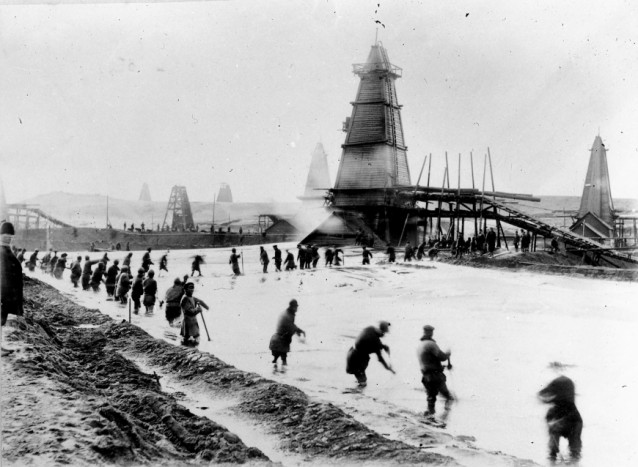 Baku oilfields before the Revolution. Photo: Azerbaijan State Photo and Film Archives
Baku oilfields before the Revolution. Photo: Azerbaijan State Photo and Film Archives
The uniqueness of the journal in the Caucasus, as well as its steadily growing popularity among the scientific community, allowed it to grow in accessibility beyond the Caspian region. From 1900 it operated a bureau in London, and by 1910 it was available in all of Russia’s major cities.
Oil Business also covered the events of oil congresses at an international level. For example, in 1901 it wrote about professor and chemist Vladimir Markovnikov who addressed the 1st International Oil Congress in Paris and stated: in Baku and Grozny oil, sulfur is only found in compounds; there is very little nitrogen, oxygen occurs in naphthenic acids... and for the most part only in heavy parts... Based on its naphthene content, the oil from Galatia is in between Russian and Pennsylvanian oil. Bibi-Heybat’s oil contains more paraffin (than Absheron oil), and Grozny oil is rich in aromatic and oxygenic hydrocarbons.
Oil Business wrote objectively, printing the real reasons behind the impending fuel crisis in the Russian oil industry, and gave positive reviews of the activities of Baku oilmen. In one article, entitled Unsubstantiated Claims, it noted: It was namely the Nobel brothers, Mantashevs, Zubalovs, Taghiyevs, Nagiyevs and others, in the capacity of industrialists and manufacturers, who carried on their shoulders a significant share of the Russian state budget, and on oil-bearing state lands they built roads, a water supply, a network of drainage canals, hospitals, schools at their own expense, which made it possible and convenient to exploit this area.
In 1911, on the 52nd anniversary of Edwin Drake drilling the first American oil well, the Drake Memorial Museum was opened. Oil Business noted at the time that the museum, in accordance with the intentions of its founders, will present the history of the oil industry, for which samples of sand, oil, tools and objects related to that time will be collected, as well as a library exclusively devoted to questions of theory and the history of the oil industry. The founders of the museum are set to make it a Mecca for all those interested in the oil industry. Oil Business seemed to be signaling the need for a similar museum in Russia where in Bibi-Heybat, Baku, oil was first drilled a full 13 years earlier than in America.
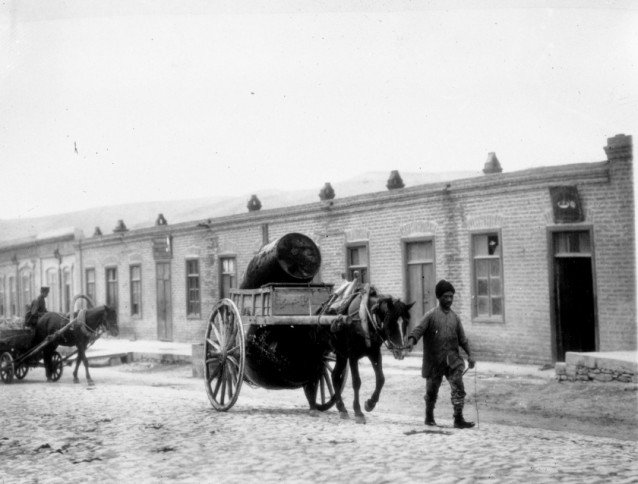 A man transporting oil from the oilfields by horse and cart before the Revolution. Photo: Azerbaijan State Photo and Film Archives
A man transporting oil from the oilfields by horse and cart before the Revolution. Photo: Azerbaijan State Photo and Film Archives
It is therefore gratifying to now see that serious construction is underway in Baku to create the largest oil museum in the Caspian region. The State Oil Company of the Azerbaijan Republic (SOCAR) underlined that the museum, which will be located behind the Bibi-Heybat Mosque, will not include a set of lifeless expositions and instead feature working examples of industrial oil production. This will include a functioning wooden well (a restoration of the first wooden oil well in the world, which was drilled in 1846), along with other samples of oil equipment and technology from that time period. Its intended audience will be schoolchildren, students and tourists, as well as anyone else interested in the rich oil history of Azerbaijan.
Standing the test of time
During World War One, Oil Business continued to function, publishing data on the status of the oil industry. It noted that the war was completely disrupting the country’s economy, and in one of its final issues of 1917, it wrote: The oil industry is meeting the offensive of 1918 under severe conditions... The situation is becoming more critical, if not to say catastrophic...
After the October Revolution of 1917, Oil Business, as well as most of the magazines published in the Russian Empire, was closed according to a decision by the Bolshevik Baku Council of People’s Commissars in May 1918. Yet just a few months later, in September 1918, the journal was reopened under the Azerbaijan Democratic Republic with a well-known journalist of the time, P. M. Kara-Murza, as its editor. It continued under its former name until March 1920 before in May of that year, after the establishment of Soviet power in Azerbaijan, it was renamed Azerbaijan Oil Industry and has remained as such to this day.
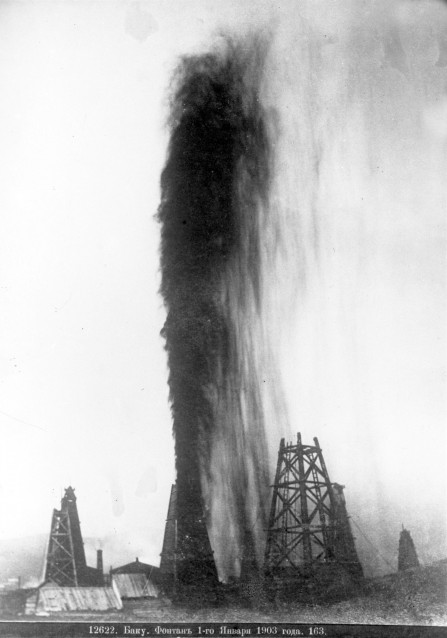 An oil fountain in one of Baku’s oilfields before the Revolution. Photo: Azerbaijan State Photo and Film Archives
An oil fountain in one of Baku’s oilfields before the Revolution. Photo: Azerbaijan State Photo and Film Archives
In its initial 20 years as Oil Business, the journal faithfully carried out the objective it had voiced in its first issue in 1899: To cover and give impartial and full coverage of both private and global problems of the Russian and world oil industry in comparison with other industries.
Currently, the journal Azerbaijan Oil Industry is published by SOCAR and headed by academician Ibrahim Guliyev. It is the oldest monthly scientific and technical journal of the oil and gas industries in the world. Throughout its existence and even today, it has published articles, essays and reviews on current issues in every area of the oil and gas industries, both in Azerbaijan and abroad. It covers a broad range of themes such as petroleum geography, geological prospecting and oil and gas exploration both on land and at sea, drilling technology and techniques, oil production, refining and petrochemicals, commercial structures and the history of the oil industry. Historically, it has been published in Azerbaijani and Russian and since 2007 – in English as well.
In the first issues of Oil Business, the journal’s address is given as: 6 Mariinskaya Street. In 1929 this street was renamed Korganov Street and in 1990 – Rasul Rza Street. Given that 2019 marks the journal’s 120th anniversary, we consider that it would be fitting to attach a memorial plaque here in memory of the first scientific oil publication in the Russian Empire.
About the author: Mir-Yusif Mir-Babayev is a doctor of chemistry, a professor at the Azerbaijan Technical University and author of books on Azerbaijan’s oil history.
